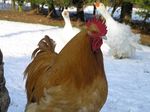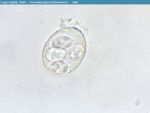Difference between revisions of "Coccidia - Poultry"
(Redirected page to Coccidiosis - Poultry) |
|||
| (5 intermediate revisions by 2 users not shown) | |||
| Line 1: | Line 1: | ||
| − | + | [[Image:Buff orpington.jpg|thumb|right|150px|Buff orpington - nabrown RVC]] | |
| + | [[Image:Eimeria Sporulated.jpg|thumb|right|150px|Sporulated ''Eimeria'' - Joaquim Castellà Veterinary Parasitology Universitat Autònoma de Barcelona]] | ||
| + | |||
| + | Domestic poultry and birds are affected by coccidia called Eimeria. Different species of Eimeria that effect poultry are host-specific – meaning that a species that infects chickens does not infect turkeys and vice versa. | ||
| + | |||
| + | Nine species of Eimeria infect chickens. The species important in broiler production include Eimeria tenella (90%), E. maxima, E. acervulina, and E. mivati; the species important in breeder and egg- layers are E. burnetti and E. necatrix. Seven species infect turkeys – the big three of concern are Eimeria meleagrimitis, E. adenoeides, and E. gallapovonis. | ||
| + | |||
| + | *Direct life cycle | ||
| + | |||
| + | *1 week prepatent period | ||
| + | |||
| + | *After oocysts are ingested, sporozoites are released which penetrate the intestinal epithelium | ||
| + | |||
| + | *2 asexual phases of multiplication called schizogony occur followed by a phase of sexual multiplication called gametogony | ||
| + | |||
| + | *Zygote develops into an oocyst which is then shed in the faeces | ||
| + | **Oocyst measures 20-30μm | ||
| + | |||
| + | *For each oocyst ingested, thousands are shed | ||
| + | |||
| + | *Life cycle is '''self-limiting''' | ||
| + | **Organisms from a single infection go through the sequence of developmental stages synchronously | ||
| + | **Organisms leave the body simultaneously as oocysts | ||
| + | |||
| + | *Oocysts are only infective once they have sporulated | ||
| + | **Sporulation requires warmth, moisture and oxygen | ||
| + | **Takes 2-3 days in broiler houses | ||
| + | |||
| + | *Oocysts contain 4 sporocysts each with 2 sporozoites | ||
| + | |||
| + | ==Literature Search== | ||
| + | [[File:CABI logo.jpg|left|90px]] | ||
| + | |||
| + | |||
| + | Use these links to find recent scientific publications via CAB Abstracts (log in required unless accessing from a subscribing organisation). | ||
| + | <br><br><br> | ||
| + | [http://www.cabi.org/cabdirect/FullTextPDF/2009/20093257328.pdf '''Coccidiosis in poultry: review on diagnosis, control, prevention and interaction with overall gut health.''' Gussem, M. de; World's Poultry Science Association (WPSA), Beekbergen, Netherlands, World Poultry Science Association, Proceedings of the 16th European Symposium on Poultry Nutrition, Strasbourg, France, 26-30 August, 2007, 2007, pp 253-261, 36 ref. - '''Full Text Article'''] | ||
| + | |||
| + | ==Test yourself with the Coccidia Flashcards== | ||
| + | |||
| + | [[Coccidia_Flashcards|Coccidia Flashcards]] | ||
| + | |||
| + | [[Category:Coccidia]][[Category:Poultry]] | ||
| + | [[Category:To_Do_-_Clinical]][[Category:To Do - Parasites]] | ||
Revision as of 23:52, 7 November 2010
Domestic poultry and birds are affected by coccidia called Eimeria. Different species of Eimeria that effect poultry are host-specific – meaning that a species that infects chickens does not infect turkeys and vice versa.
Nine species of Eimeria infect chickens. The species important in broiler production include Eimeria tenella (90%), E. maxima, E. acervulina, and E. mivati; the species important in breeder and egg- layers are E. burnetti and E. necatrix. Seven species infect turkeys – the big three of concern are Eimeria meleagrimitis, E. adenoeides, and E. gallapovonis.
- Direct life cycle
- 1 week prepatent period
- After oocysts are ingested, sporozoites are released which penetrate the intestinal epithelium
- 2 asexual phases of multiplication called schizogony occur followed by a phase of sexual multiplication called gametogony
- Zygote develops into an oocyst which is then shed in the faeces
- Oocyst measures 20-30μm
- For each oocyst ingested, thousands are shed
- Life cycle is self-limiting
- Organisms from a single infection go through the sequence of developmental stages synchronously
- Organisms leave the body simultaneously as oocysts
- Oocysts are only infective once they have sporulated
- Sporulation requires warmth, moisture and oxygen
- Takes 2-3 days in broiler houses
- Oocysts contain 4 sporocysts each with 2 sporozoites
Literature Search
Use these links to find recent scientific publications via CAB Abstracts (log in required unless accessing from a subscribing organisation).
Coccidiosis in poultry: review on diagnosis, control, prevention and interaction with overall gut health. Gussem, M. de; World's Poultry Science Association (WPSA), Beekbergen, Netherlands, World Poultry Science Association, Proceedings of the 16th European Symposium on Poultry Nutrition, Strasbourg, France, 26-30 August, 2007, 2007, pp 253-261, 36 ref. - Full Text Article


